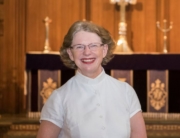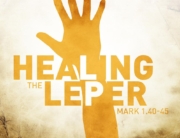A sermon given during the 10:30am Choral Eucharist, by The Rev’d Dr Lynn Arnold AO on the 25th February 2024.
LIFTING THE PAINTED VEIL
May the words of my mouth and the meditations of our hearts be worthy in your sight, O Lord, our Rock and our Redeemer. Amen.
In 1818, the Romantic poet, Percy Bysshe Shelley, wrote the sonnet, Lift not the painted veil, which opens with these lines:
Lift not the painted veil which those who live
Call Life: though unreal shapes be pictured there,
And it but mimic all we would believe
Shelley was an atheist and so his sonnet not only alluded to the way we create the illusion of reality in this life – ‘the painted veil which those who live call life’ – but also contended that there was nothing beyond this temporal existence and that any suggestion of a reality which transcended the temporal was merely ‘mimic of all we would believe’. The sonnet speaks bleakly of someone who sought for some deeper truth beyond that painted veil:
He sought …
A splendour among shadows, a bright blot
Upon this gloomy scene, a Spirit that strove
For truth, and like the Preacher found it not.
Shelley did not believe there was anything behind the painted veil of that illusion we call life. By our presence here this morning, we have indicated that we do not agree with his contention. Nor did Jesus’ disciples, those twelve who dropped all previous normality in their lives by following a wandering rabbi who had seemed to know something so much more about the meaning of life than that which they had ascertained up to that point in their very ordinary existences.
Our reading from Mark’s gospel this morning finds us at a very interesting point in the experience of those twelve who had chosen to follow Jesus. Up to the point of our reading, they had encountered a deeply thoughtful man who could explain profound truths through parables (the Parable of the Sower [4:1-20], Parable of the Growing Seed [4:26-29], Parable of the Mustard Seed [4:30-32] amongst many others [4:33]). He also had amazing powers of healing [such as the restoring a demon-possessed man [5:1-20], raising a seemingly dead girl and healing a sick woman [5:21-43], as well as mass healings at Gennesaret [6:55-56], followed by the healing of the daughter of the Syro-Phoenician woman [7:25-30], the healing of a deaf mute [7:31-37] and the restoring of sight to the blind man at Bethsaida [8:2226]). Faith healers were not unknown in that time, but this unusual rabbi took the power of the miraculous to an entirely new level – vide his calming of the storm [4:35-41] and walking on water [6:45-52] and the mass feedings from almost no food – first the five thousand [6:30-42] and then the four thousand [8:1-9]. All of this Jesus did while philosophising profoundly on the ways of humanity:
People can be forgiven all their sins and every slander they utter, but whoever blasphemes against the Holy Spirit will never be forgiven. [3:28-29]
For whatever is hidden is meant to be disclosed, and whatever is concealed is meant to be brought out into the open. If anyone has ears to hear, let them hear. [4:22-23]
A prophet is not without honour except in his own town [6:4]
Nothing outside a person can defile them by going into them. Rather, it is what comes out of a person that defiles them. [7:15]
More than that, these disciples heard him go beyond such philosophising to broach the subject of faithful responding:
Do you bring in a lamp to put it under a bowl or a bed? Instead, don’t you put it on its stand? [4:21]
Calling the twelve to him, he began to send them out two by two and gave them authority over impure spirits. [6:7]
This then had been the experience of the twelve in relation to this wandering rabbi up to the point of our gospel reading this morning. They clearly had become very impressed by what they had seen and heard to that point. Not only that, it was clear the rabbi’s message had been gaining significant traction amongst the community – this amazing man knew how to grow his audience. After the healing of the deaf-mute, the gospel records:
People were overwhelmed with amazement. ‘He has done everything well’ they said. [7:37]
One can almost imagine that a smugness had developed amongst the disciples; that they knew they had been right to cast in their lot with this man. Perhaps testing them, Jesus had then asked his disciples ‘who do you say I am?’ [8:29], to which Peter had boldly responded:
You are the Messiah [8:29]
Yes, they were convinced that this Jesus was much more than an exceptional preacher, he was the foretold Messiah. You can almost see the nodding of the heads of the other eleven as Peter said these dramatic words. They were certain what the journey ahead held for them and for Jesus. He would go on healing, performing miracles and teaching with great wisdom; and, as a result, people would follow him in increasing numbers until such time as everyone would acclaim him as Messiah. Hallelujah!
It was at this point then that our reading this morning picks up the ongoing story; relating that moment when Jesus seemed to go seriously off-message. He said not only to the twelve but quite openly to all those present [8:32]:
The Son of Man must undergo great suffering, and be rejected by the elders, the chief priests and the scribes, and be killed, and after three days rise again. [8:31]
No, no, no! That can’t be right – suffering, rejection, execution – no, no, no! That won’t win followers; it’s illogical – no-one is looking for more suffering! Thinking that Jesus had seriously lost the plot, Peter urgently spoke on behalf of the now confused twelve:
Peter took Jesus aside and began to rebuke him. [8:32]
In other words, Peter gave worldly advice to Jesus; one can almost imagine the conversation:
Look, Jesus, what are you saying? This is crazy! By everything you have been doing and saying these past months, you have got people in the palm of your hand. They are ready to come to you en masse. They will accept anything you say – anything that is but what you have just said! Quick, you had better go and set the record straight.
The response of Jesus? Well, you have heard it many times over before this morning:
Get behind me, Satan! [8:33]
Followed by these vital words:
For you are setting your mind not on divine things but on human things. [8:33]
The disciples had stopped on their journey with Christ at his good words and good works. They had stopped at the limits of the human agenda of understanding; Jesus was now telling them they needed to look at the divine purpose. This was not only the key message to the confused disciples; it was and is the seminal message to all of us who would follow Jesus – set your mind on the divine, not the temporal. Move beyond the good words and good works to the crucifixion and the resurrection.
Shelley would have found the question irrelevant – for him, there was nothing behind the painted veil, the humanly-created reality of this life. Any attempt to say otherwise was simply the vain seeking of a truth which could not be found. Jesus would doubtless have said to Shelley to get behind him as he was incapable of understanding what he was saying. Shelley wasn’t a believer, but what of those of us who are?
How would we have responded at that point of journeying with Jesus? Indeed, even knowing what we now know – that the good words and the good works ended in crucifixion, which was followed by resurrection – how do we really respond? In his book Beyond Belief, Hugh Mackay has had this to say about the resurrection:[1]
The resurrection presents serious difficulties to a person trying to reconcile Christian faith with reason.
Echoing Peter’s rebuke, Mackay went on:[2]
The resurrection works as a metaphor for the endless cycle of life, death and regeneration in the natural world … it symbolises hope and renewal – a counterpoint to the sense of shock and outrage that Christians feel whenever they contemplate the possibility that such a good man could be put to death in such a brutal and humiliating way. For many Christians, it is a story about the continuing influence of Jesus and his teachings, and how the Jesus movement was unstoppable, even by the crucifixion of its leader.
Shelley was right that the ‘painted veil called Life’ is ephemeral and goes away. But he was wrong in believing there was nothing behind it. We are in the opening weeks of this year’s Lenten journey affirming our belief about how wrong Shelley was. But Lent should be more than just a time of affirmation, but also a time of self-interrogation about our own faith. Do we stop at the good words and good works as the disciples had that day, or do we truly understand the shocking forthtelling of Christ’s destination being the Cross? Our gospel reading this morning should not only be heard by us to be a rebuke of Peter but a question which Jesus poses to each of us:
Despite what we might profess, do we really set our minds on divine things or do human things shape us?
What does the evidence of our believing say? Is our faith merely a mimic of our worldly perceptions, where the lifted veil reveals no more than a dead Christ on the cross? Or have we lifted the painted veil of this life to find Christ risen from the crucifixion?
[Addition for the 10.30am service]
Shortly, we are about to participate in the sacrament of baptism for Agnes, Sigourney and Alfred. In this sacred moment, we will welcome them into our fellowship of believers and into a special relationship with God through Christ. In the baptismal service some rather awesome words will be said:
May they be made one with Christ in his death and resurrection. May they die to sin, rise to newness of life, and continue forever in Jesus Christ.
By these words, we will be saying to Agnes, Sigourney that Alfred that the veil of this life is not something final, finishing upon death, but a gateway, through Christ, to life everlasting.
[1] H Mackay, Beyond Belief: How we find meaning, with or without religion, Macmillan, 2016, p217.
[2] Op.cit, pp218-9.




